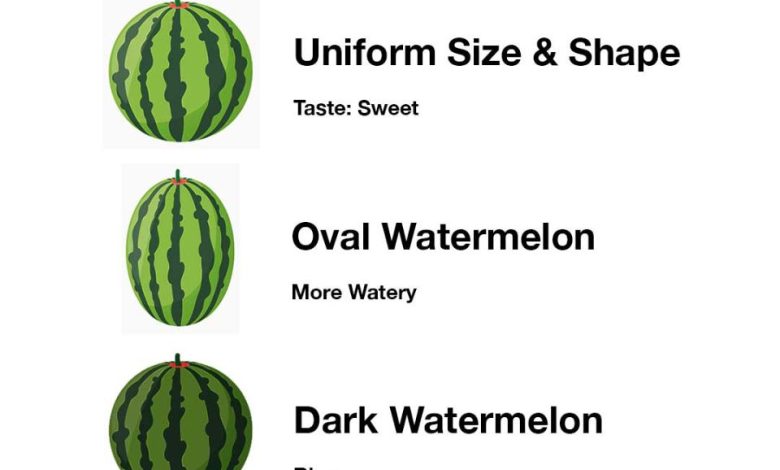You are doing it wrong. Here’s the step-by-step guide on picking a watermelon purely based on looks

Ah, summertime. Few things evoke its essence quite like the refreshing taste of a perfectly ripe watermelon, its juicy flesh bursting with sweetness on a hot day. But how do you ensure you bring home a watermelon that lives up to this idyllic image? While some swear by the “thump test,” a truly masterful approach relies solely on visual inspection. Here’s a step-by-step guide to transform you into a watermelon-picking pro:
ADVERTISEMENT
Step 1: Seek the Symmetrical Shape
ADVERTISEMENT
Watermelons come in two main shapes: round and oval. The key here is uniformity. Look for a watermelon that’s consistent in shape, free of any major bumps or irregularities. A symmetrical form suggests even growth, which often translates to a more consistent distribution of sugars throughout the fruit.
ADVERTISEMENT
Step 2: Unveiling the Secrets of the Field Spot
Flip the watermelon over. The spot where it rested on the vine is called the field spot. This seemingly mundane detail holds a wealth of information. Here’s what you’re looking for: a creamy yellow patch, almost like butter in color. This yellow hue is due to a pigment called carotene, which increases with sun exposure during ripening. A large, creamy yellow field spot indicates the watermelon spent ample time on the vine, soaking up sunshine and developing its sweetness.
Step 3: Let the Stripes Tell the Tale
Now, turn your attention to the watermelon’s green exterior. Ideally, you want a deep, consistent green color. The stripes, too, should be well-defined. Science plays a role here: chlorophyll, the pigment responsible for the green color, diminishes as the fruit ripens. So, a deeper green with clear, defined stripes suggests a watermelon that’s nearing peak ripeness.
Step 4: From Shiny to Dull, a Transformation
The texture of the rind is another crucial indicator. A perfectly ripe watermelon will have a dull appearance, not a shiny one. That shine signifies an immature fruit, with less developed sugars and potentially thicker rinds. A dull rind, on the other hand, suggests the waxy layer on the watermelon’s surface has matured, a hallmark of ripeness.
Step 5: Webbing – A Sign of Sweet Secrets?
Take a closer look at the surface of the watermelon. Do you see brown, web-like patterns? These are known as webbing. While not a foolproof sign, some believe webbing indicates areas where bees pollinated the fruit multiple times. Increased pollination can lead to a higher concentration of sugars, making the watermelon potentially sweeter.
Step 6: Weight Matters, But Not Arbitrarily
While size isn’t the sole determinant of quality, here’s a helpful tip: pick up two watermelons of similar size. The one that feels heavier is likely the riper choice. Why? As a watermelon ripens, its water density increases. This means a ripe watermelon will feel denser and consequently heavier for its size compared to an underripe one.
Step 7: The Stem Speaks Volumes (Well, Not Literally)
While not the most crucial factor, the stem can offer a hint about freshness. Ideally, the stem should be brown and dry. A green stem suggests the watermelon was picked prematurely. If the stem is completely absent, don’t fret – some watermelons are picked with the stem already detached. In such cases, you can examine the blossom end (opposite the stem) for a small, slightly indented scar – another indicator of proper detachment from the vine.
Common Mistakes to Avoid: Picking Like a Pro
Now that you’re armed with these visual cues, let’s address some common mistakes to steer you clear of disappointment:
- Ignoring the Field Spot: A white or nonexistent field spot suggests the watermelon wasn’t fully ripe.
- Not Considering the Skin: A shiny rind is a sign of an underripe watermelon.
- Size Alone Doesn’t Guarantee Quality: Medium-sized watermelons often have a better balance of sweetness and texture compared to giants.
- Forgetting to Inspect the Surface: Blemishes, cuts, or bruises can indicate damage or poor handling, affecting the fruit’s quality.
The Final Slice: Bringing Home Watermelon Perfection
Remember, the key lies in a combination of these visual cues. By seeking a uniform shape, a creamy yellow field spot, deep green color with defined stripes, a dull rind, potential webbing, and a weight that feels substantial for its size, you’ll be well on your way to picking the perfect watermelon every single time. And as a final tip, remember that watermelons are typically at their peak during the summer months, so time your selection accordingly to enjoy the fruit at its absolute best. Now go forth and conquer the watermelon patch – with your newfound knowledge, you’re sure to become a watermelon-picking champion




